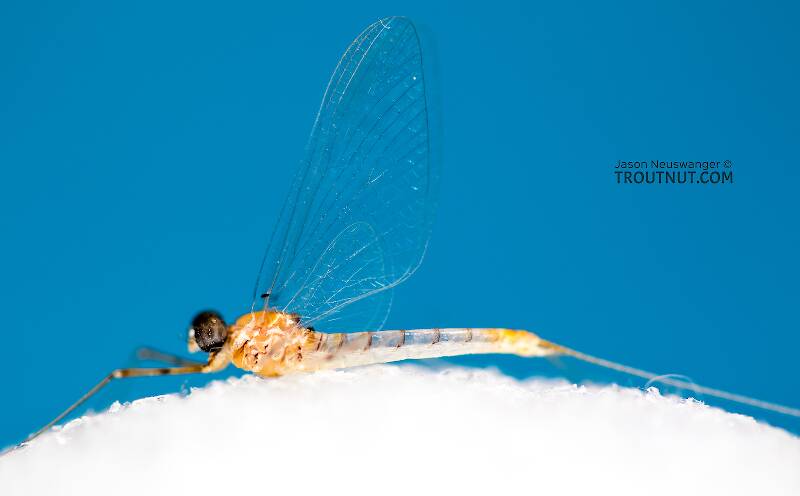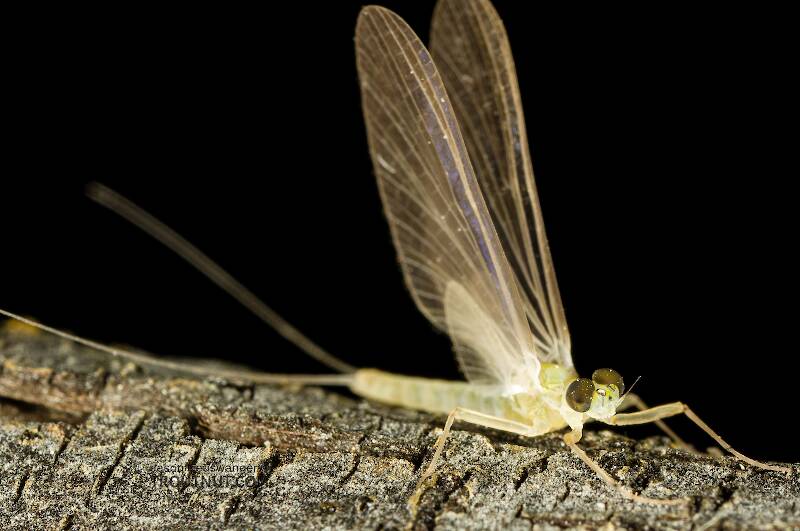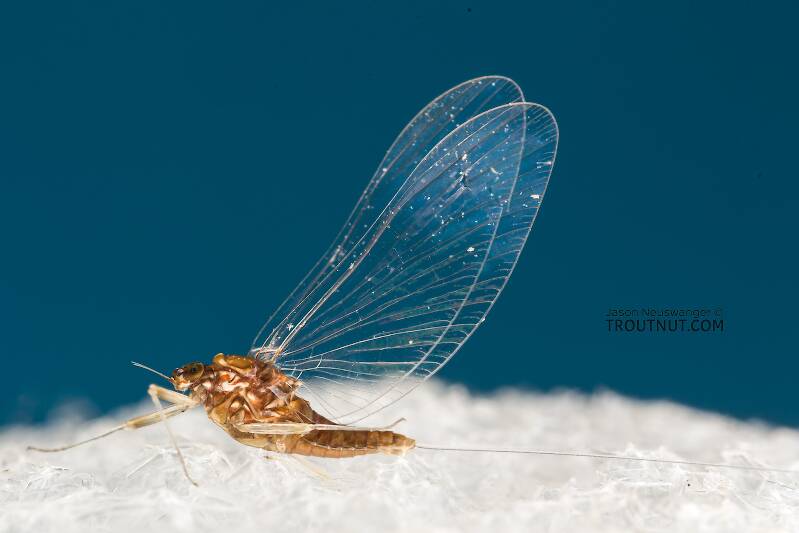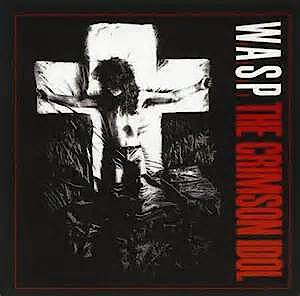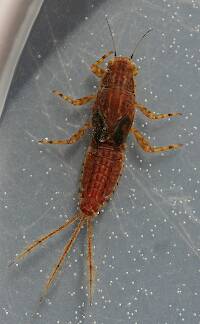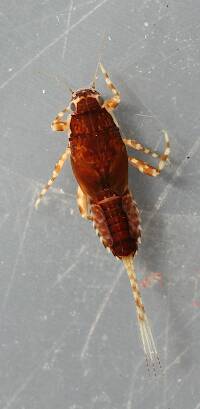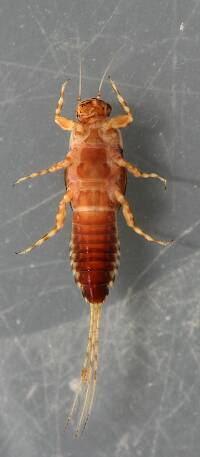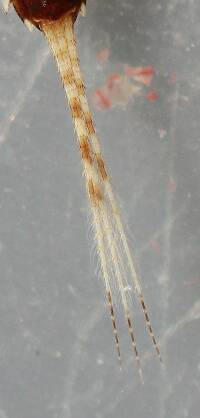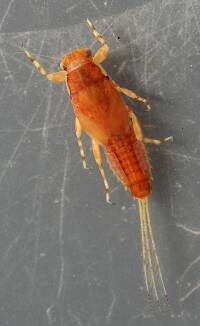
Salmonflies
Pteronarcys californica
The giant Salmonflies of the Western mountains are legendary for their proclivity to elicit consistent dry-fly action and ferocious strikes.
Featured on the forum
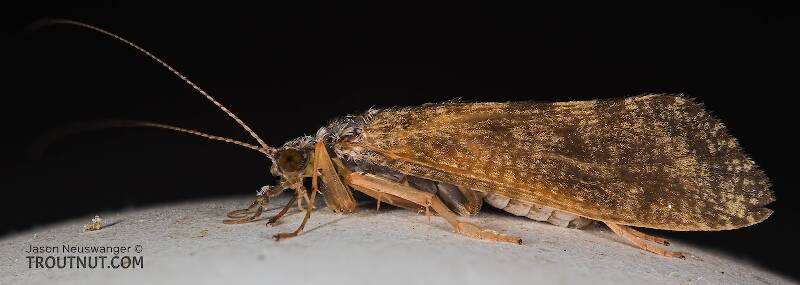

Troutnut is a project started in 2003 by salmonid ecologist Jason "Troutnut" Neuswanger to help anglers and
fly tyers unabashedly embrace the entomological side of the sport. Learn more about Troutnut or
support the project for an enhanced experience here.
This topic is about the Insect Order Ephemeroptera
Mayflies may be the most important insects for trout anglers to understand. They are an ancient order of insects, famous outside the fly-fishing world for their fragile beauty and short adult lifespan, often a single day to mate and die. The mayfly's poignant drama attracts poets and anglers alike, but anglers make the most of it.Mayflies live more than 99% of their lives as nymphs on the river or lake bottom, filling many crucial roles in freshwater ecosystems as they feed and grow. They eventually emerge from the water as winged sub-adults called "subimagos" by scientists and "duns" by anglers. Duns evolved to be good at escaping the water, with a hydrophobic surface and hardy build, but they are clumsy fliers. Within a day or two they molt one last time into "imagos" or "spinners," the mature adults, a transformation captured in this photo series of a dun molting into a spinner. They have longer legs and tails, and sleeker, more lightweight bodies, giving them the airborne speed, agility, and long grasp they need for their midair mating rituals. They are usually darker than the duns and have shinier, more transparent wings. They die within minutes or hours after mating.
Example specimens
Gutcutter on Jul 23, 2011July 23rd, 2011, 6:06 am EDT
Since this has been raised in other threads, and I find it fascinating, I'm going to start it. I hope that this does not offend anyone, nor start a war.
So...here goes:
Homo sapiens has 46 chromosomes and a ton of DNA variance.
From an anatomic standpoint - they have the same components, but certain groups possess:
different coloration
different head shapes and facial characteristics
diverse body configuration (not related to amount of food consumed)
various relative leg and arm lengths
...
I could go on and on.
We are not on this planet anywhere near the length of time that mayflies have existed, but there are distinct anatomic and genetic differences among us - yet we remain lumped into the same species.
So, the major question that I raise is:
what are the major genetic differences between (for example) invaria and subvaria or infrequens and dorothea that keep them separate, and what is so close about them that vicarium and fuscum have now been "lumped together?
I look forward (I think) to the answers - both scientific and non scientific
So...here goes:
Homo sapiens has 46 chromosomes and a ton of DNA variance.
From an anatomic standpoint - they have the same components, but certain groups possess:
different coloration
different head shapes and facial characteristics
diverse body configuration (not related to amount of food consumed)
various relative leg and arm lengths
...
I could go on and on.
We are not on this planet anywhere near the length of time that mayflies have existed, but there are distinct anatomic and genetic differences among us - yet we remain lumped into the same species.
So, the major question that I raise is:
what are the major genetic differences between (for example) invaria and subvaria or infrequens and dorothea that keep them separate, and what is so close about them that vicarium and fuscum have now been "lumped together?
I look forward (I think) to the answers - both scientific and non scientific
All men who fish may in turn be divided into two parts: those who fish for trout and those who don't. Trout fishermen are a race apart: they are a dedicated crew- indolent, improvident, and quietly mad.
-Robert Traver, Trout Madness
-Robert Traver, Trout Madness
Taxon on Jul 23, 2011July 23rd, 2011, 7:35 am EDT
Hi Tony-
Thanks for bringing up the question of what constitutes the taxonomic unit, species, and why. This is a question which anyone who acquires a passion for taxonomy must eventually confront. Your post appears to ignore the primary species determinant, that being the capability of interbreeding and producing fertile offspring. In any event, I look forward to seeing the responses of others to the question you posed, as I'm certain we will all learn something in the process. :-)
Thanks for bringing up the question of what constitutes the taxonomic unit, species, and why. This is a question which anyone who acquires a passion for taxonomy must eventually confront. Your post appears to ignore the primary species determinant, that being the capability of interbreeding and producing fertile offspring. In any event, I look forward to seeing the responses of others to the question you posed, as I'm certain we will all learn something in the process. :-)
Konchu on Jul 23, 2011July 23rd, 2011, 7:47 am EDT
what are the major genetic differences between (for example) invaria and subvaria or infrequens and dorothea that keep them separate, and what is so close about them that vicarium and fuscum have now been "lumped together?
I look forward (I think) to the answers - both scientific and non scientific
To be brief, these decisions historically have been based on mostly, if not entirely, on the morphological and color variation that you mentioned being observed in series of specimens from throughout the ranges of the various nominal species. When these variations overlap or coincide, and correspond to similar variation known for other closely related groups, then synonymy is one way of recognizing this.
When I 'lumped' Ephemerella dorothea and Ephemerella infrequens, I did so based on seeing identical variants from both the eastern and western populations, and I saw that the range of color and size variation encompassed the 'type' concepts of both. Furthermore, the species showed similar ecologies. I retained subspecies designations, however, to reflect the disjunct populations and consequent reproductive isolation. At the time, molecular devices were not in my toolkit for a number of reasons.
However, now that we are using molecular tools (e.g., DNA barcoding), we're seeing things that sometimes bring into question historical decisions and sometimes corroborate them.
People sometimes get frustrated, and rightfully so, for continual taxonomic changes; however, taxonomy is a science, and it is plastic. If a science is static, then it probably is not science at all. Taxonomy sometimes is criticized for a lack of hypothesis testing, but its plasticity shows that hypotheses are tested and refuted all the time. A species or a genus, for example, are in and of themselves hypotheses.
Konchu on Jul 23, 2011July 23rd, 2011, 7:53 am EDT
Your post appears to ignore the primary species determinant, that being the capability of interbreeding and producing fertile offspring.
In part, yes. But what about parthenogenetic species, those that do not require sexual reproduction? And there are cases of obligate and facultative parthenogenesis. Plant, protist and bacterial species make things even more complicated. And what about cases of polyploidy? There are dozens and dozens of species concepts, the interbreeding species that you mentioned being just one. I think it was a fine question.
GONZO on Jul 23, 2011July 23rd, 2011, 8:09 am EDT
Hi Tony,
Here is my strictly amateur take, based primarily on my reading (interpretation) of the literature that I have seen, with a few personal observations thrown in:
As Jeff Webb mentioned in the "Heptageniid Nymph" thread, taxonomists use morphological, ecological, and (now) DNA differences to help determine species.
Basically, E. subvaria and E. invaria are distinct in all of those areas. They have distinct morphology; they have different emergence periods, habitat requirements, and environmental tolerences; though they are closely related, their mtDNA sequence divergence is an order of magnitude greater than conspecifics.
As for E. infrequens and E. dorothea, they are not currently listed as distinct species. Instead, they are E. dorothea infrequens and E. dorothea dorothea. These can differ in terms of color, perhaps some aspects of morphology, and geography, but have been considered subspecies. [Edit: see Konchu's post above.]
However (and here's where the DNA plot thickens), both the "new" E. invaria (including current synonyms) and "old" E. dorothea have been shown to contain distinct "clades." It has long been suspected that E. invaria (in the current sense) was actually a species group, and it seems that the old E. rotunda might (?) be a "good" species (though even this seems to include two distinct clades). There is also a deep divergence between the eastern "old" E. dorothea and the western "old" E. infrequens. Some of these clades or "cryptic" species cannot be reliably distinguished (at this time) by morphological characters. (See Alexander et al. 2009.)
As for the "old" March Brown (vicarium) and Grey Fox (fuscum), taxonomists and anglers once thought that they could be distinguished by size, color, markings, and perhaps emergence period. The DNA analysis that I have seen (Ball et al. 2005) showed an average divergence of 3.4%. This was at the high end of intraspecific divergence, but not nearly as high as the divergence between some of the groups mentioned above. The supposed size difference (vicarium larger and fuscum smaller) is probably a myth based on limited samples and the perpetuation of that distinction in angling literature. For example, Jason has a photo of a nymph that would have been identified as "fuscum" under the old system, but is already (in April) in the upper part of the size range given for "old" vicarium (#479 @ ~15mm). Distinctions that are used in older taxonomic (and angling) texts, particularly the ventral markings of the nymphs, have been shown to be opposite ends of a continuum, and nymphs that might have been identified as one species under the old system can produce adults that look like the other species. Differences in emergence period are also probably a myth, and even angling texts that describe them as two species (and they would have been considered that at the time) mention that the one ("fuscum") that was supposed to emerge after the other ("vicarium") could appear to emerge before. (See Caucci and Nastasi's original 1975 Hatches, pg. 155.)
I'm sure that's all as clear as mud, and I hope I haven't made too many egregious mistakes in interpreting the literature. I expect that we might be seeing further changes with regard to E. invaria and E. dorothea, but I also suspect that M. vicarium might remain basically as it is. (Again, just my strictly amateur sense of things.) Curiously, the supposed distinctions between the March Brown and the Grey Fox are the ones that some anglers continue to insist are real, while most of the others have been accepted with far less fuss. :)
Best,
Lloyd
Here is my strictly amateur take, based primarily on my reading (interpretation) of the literature that I have seen, with a few personal observations thrown in:
what are the major genetic differences between (for example) invaria and subvaria or infrequens and dorothea that keep them separate, and what is so close about them that vicarium and fuscum have now been "lumped together?
As Jeff Webb mentioned in the "Heptageniid Nymph" thread, taxonomists use morphological, ecological, and (now) DNA differences to help determine species.
Basically, E. subvaria and E. invaria are distinct in all of those areas. They have distinct morphology; they have different emergence periods, habitat requirements, and environmental tolerences; though they are closely related, their mtDNA sequence divergence is an order of magnitude greater than conspecifics.
As for E. infrequens and E. dorothea, they are not currently listed as distinct species. Instead, they are E. dorothea infrequens and E. dorothea dorothea. These can differ in terms of color, perhaps some aspects of morphology, and geography, but have been considered subspecies. [Edit: see Konchu's post above.]
However (and here's where the DNA plot thickens), both the "new" E. invaria (including current synonyms) and "old" E. dorothea have been shown to contain distinct "clades." It has long been suspected that E. invaria (in the current sense) was actually a species group, and it seems that the old E. rotunda might (?) be a "good" species (though even this seems to include two distinct clades). There is also a deep divergence between the eastern "old" E. dorothea and the western "old" E. infrequens. Some of these clades or "cryptic" species cannot be reliably distinguished (at this time) by morphological characters. (See Alexander et al. 2009.)
As for the "old" March Brown (vicarium) and Grey Fox (fuscum), taxonomists and anglers once thought that they could be distinguished by size, color, markings, and perhaps emergence period. The DNA analysis that I have seen (Ball et al. 2005) showed an average divergence of 3.4%. This was at the high end of intraspecific divergence, but not nearly as high as the divergence between some of the groups mentioned above. The supposed size difference (vicarium larger and fuscum smaller) is probably a myth based on limited samples and the perpetuation of that distinction in angling literature. For example, Jason has a photo of a nymph that would have been identified as "fuscum" under the old system, but is already (in April) in the upper part of the size range given for "old" vicarium (#479 @ ~15mm). Distinctions that are used in older taxonomic (and angling) texts, particularly the ventral markings of the nymphs, have been shown to be opposite ends of a continuum, and nymphs that might have been identified as one species under the old system can produce adults that look like the other species. Differences in emergence period are also probably a myth, and even angling texts that describe them as two species (and they would have been considered that at the time) mention that the one ("fuscum") that was supposed to emerge after the other ("vicarium") could appear to emerge before. (See Caucci and Nastasi's original 1975 Hatches, pg. 155.)
I'm sure that's all as clear as mud, and I hope I haven't made too many egregious mistakes in interpreting the literature. I expect that we might be seeing further changes with regard to E. invaria and E. dorothea, but I also suspect that M. vicarium might remain basically as it is. (Again, just my strictly amateur sense of things.) Curiously, the supposed distinctions between the March Brown and the Grey Fox are the ones that some anglers continue to insist are real, while most of the others have been accepted with far less fuss. :)
Best,
Lloyd
Konchu on Jul 23, 2011July 23rd, 2011, 8:46 am EDT
Looks like there's been some simultaneous posting, but I think we all basically said the same things from different perspectives.
PaulRoberts on Jul 23, 2011July 23rd, 2011, 8:52 am EDT
These outermost branches of these "clades" Lloyd brings up represent evolution in motion so to speak. Insects evolve (change) more quickly over time bc of their rapid generational time frame, the structural and functional diversity of their habitats (lotsa niches to divvy up), and strong selective pressures.
Homo sapiens has relieved itself of many selective pressures, become global in distribution, and are seeing cultural diversity eroding. Compare that to insects, or bacteria, where the concept of easily definable (follow the rules) STABLE species begins to melt, looking like a braided and inter-braided channel through a given time frame, rather than a definable stream.
The conceptual problem comes in when we try to think of life in static units rather than as a snap-shots in a (very old) time stream.
Homo sapiens has relieved itself of many selective pressures, become global in distribution, and are seeing cultural diversity eroding. Compare that to insects, or bacteria, where the concept of easily definable (follow the rules) STABLE species begins to melt, looking like a braided and inter-braided channel through a given time frame, rather than a definable stream.
The conceptual problem comes in when we try to think of life in static units rather than as a snap-shots in a (very old) time stream.
GONZO on Jul 23, 2011July 23rd, 2011, 9:39 am EDT
BTW, while re-reading Alexander et al. (2009) in an attempt share that information as accurately as I know how, I noticed this comment (in the abstract) about another species that has recently been under discussion:
...just thought that was interesting.
Western samples of Ephemerella aurivillii were so genetically distant from all other [Ephemerella] lineages (32.2%) that doubt about its congeneric status is raised.
...just thought that was interesting.
Konchu on Jul 23, 2011July 23rd, 2011, 9:45 am EDT
BTW, while re-reading Alexander et al. (2009) in an attempt share that information as accurately as I know how, I noticed this comment (in the abstract) about another species that has recently been under discussion:
Western samples of Ephemerella aurivillii were so genetically distant from all other [Ephemerella] lineages (32.2%) that doubt about its congeneric status is raised.
...just thought that was interesting.
Ephemerella aurivillii is the type species of the genus name Chitonophora, a name that has been in synonymy with Ephemerella since 1930. I upheld the synonymy in 2008, but am investigating it further in collaboration with others, using molecular means. Any change likely will require a compelling case from multiple data sources.
GONZO on Jul 23, 2011July 23rd, 2011, 10:04 am EDT
Thanks for the update, Luke. Some anglers seem to be under the impression that DNA analysis is supplanting morphology or ecology with regard to species determination. Could you comment on the interdependence of those parts of the "toolkit," particularly the ways that DNA analysis currently relies on "traditional" taxonomy?
Konchu on Jul 23, 2011July 23rd, 2011, 10:25 am EDT
here's one example. jeff and i and others are working to build a dna reference library for mayflies and other aquatic insects. traditional IDs supply the basis for at least the initial application of names and sometimes for the choices of which specimens to use for tissue/dna extraction. later we might see different clusters with the same name on them. so, we redo the morphological examinations and discover either that morphology differences exist or do not. in some cases these differences correspond to existing names (synonyms), other times not. sometimes no difference is found, so other factors such as ecology come under scrutiny. in other examples, molecular means are used for the first sorting of specimens.
i've been to talks and seminars and read papers that touted molecular data and really were intimating the supremacy of it over traditional, morphological means of identification, which some consider passe. but under questioning, it was revealed that all of their IDs (and thus part of their conclusions, too) were based on morphology. even in the case of strictly molecular ids (where names are applied), if you went back far enough, there was a specimen identified by its appearance that served as the basis for the first id. we're coming to a time, though, when the name-bearing types of species might be sampled for DNA, and the DNA can be used alone to apply the names.
both kinds of id, molec and morpho, are just ways of sorting. when they agree, it's nice. when they do not agree, it's interesting.
i've been to talks and seminars and read papers that touted molecular data and really were intimating the supremacy of it over traditional, morphological means of identification, which some consider passe. but under questioning, it was revealed that all of their IDs (and thus part of their conclusions, too) were based on morphology. even in the case of strictly molecular ids (where names are applied), if you went back far enough, there was a specimen identified by its appearance that served as the basis for the first id. we're coming to a time, though, when the name-bearing types of species might be sampled for DNA, and the DNA can be used alone to apply the names.
both kinds of id, molec and morpho, are just ways of sorting. when they agree, it's nice. when they do not agree, it's interesting.
GONZO on Jul 23, 2011July 23rd, 2011, 10:27 am EDT
Perfect. Thank you!
Konchu on Jul 23, 2011July 23rd, 2011, 10:41 am EDT
Perfect. Thank you!
Since I've achieved Nirvana, I shall stop here. Hopefully Jeff has not been scared away (per certain others' concerns), and he will have more to add.
Troutnut on Jul 23, 2011July 23rd, 2011, 11:04 am EDT
People sometimes get frustrated, and rightfully so, for continual taxonomic changes; however, taxonomy is a science, and it is plastic. If a science is static, then it probably is not science at all. Taxonomy sometimes is criticized for a lack of hypothesis testing, but its plasticity shows that hypotheses are tested and refuted all the time. A species or a genus, for example, are in and of themselves hypotheses.
Brilliantly said, Luke. I put that on the all-time-best-quotes-of-the-forum list.
Jason Neuswanger, Ph.D.
Troutnut and salmonid ecologist
Troutnut and salmonid ecologist
PaulRoberts on Jul 23, 2011July 23rd, 2011, 1:44 pm EDT
Yes, just excelllent Luke. But...not perfect, yet. There's still more work to do. :)
Oldredbarn on Jul 25, 2011July 25th, 2011, 8:54 am EDT
These "clades" Lloyd brings up represent evolution in motion so to speak. Insects evolve (change) more quickly over time bc of their rapid generational time frame, the structural and functional diversity of their habitats (lotsa niches to divvy up), and strong selective pressures.
Homo sapiens has relieved itself of many selective pressures, become global in distribution, and are seeing cultural diversity eroding. Compare that to insects, or bacteria, where the concept of easily definable (follow the rules) STABLE species begins to melt, looking like a braided and inter-braided channel through a given time frame, rather than a definable stream.
The conceptual problem comes in when we try to think of life in static units rather than as a snap-shots in a (very old) time stream.
Paul...IMHO. This is good stuff!
Spence
"Even when my best efforts fail it's a satisfying challenge, and that, after all, is the essence of fly fishing." -Chauncy Lively
"Envy not the man who lives beside the river, but the man the river flows through." Joseph T Heywood
"Envy not the man who lives beside the river, but the man the river flows through." Joseph T Heywood
Adirman on Jul 26, 2011July 26th, 2011, 2:11 am EDT
These "clades" Lloyd brings up represent evolution in motion so to speak. Insects evolve (change) more quickly over time bc of their rapid generational time frame, the structural and functional diversity of their habitats (lotsa niches to divvy up), and strong selective pressures.
I wonder if this is at least part of the reason that fly tying patterns that dominate the market today are very different from the very old patterns from the early 1900's and even older. Also, although certainly there are common attractor patterns effective almost everywhere, flies that work in France and are "local" patterns may not work very well at all in the Catskills, for example, and vice-versa.
I wonder if this is at least part of the reason that fly tying patterns that dominate the market today are very different from the very old patterns from the early 1900's and even older. Also, although certainly there are common attractor patterns effective almost everywhere, flies that work in France and are "local" patterns may not work very well at all in the Catskills, for example, and vice-versa.
Gutcutter on Jul 26, 2011July 26th, 2011, 4:47 am EDT
I wonder if this is at least part of the reason that fly tying patterns that dominate the market today are very different from the very old patterns from the early 1900's and even older. Also, although certainly there are common attractor patterns effective almost everywhere, flies that work in France and are "local" patterns may not work very well at all in the Catskills, for example, and vice-versa.
The tyers and fisherman of yesteryear didn't have the tools nor materials to tie the flies of today. no small hooks and no GENETIC hackle (see, I kept it in the context of this thread topic) let alone no modern synthetics.
However, Gordon's flies of a hundred years ago can be very effective for the larger mayflies even today.
The major differences in fly construction are related to the education of the multiply caught fish and the numerous fishermen that are after them.
Flyfishing Pressured Water requires (in general), new Tying Tactics for Today's Trout
Yes, that is an obvious plug for Gonzo's book
;)
All men who fish may in turn be divided into two parts: those who fish for trout and those who don't. Trout fishermen are a race apart: they are a dedicated crew- indolent, improvident, and quietly mad.
-Robert Traver, Trout Madness
-Robert Traver, Trout Madness
Adirman on Jul 26, 2011July 26th, 2011, 2:17 pm EDT
Gutcutter;
Good points on the technology in tying thing being the major diff. between then and now but do you think that a Quill Gordon captured from a Catskill stream in 1890 would look much different than those of today? And if so, do you think that also would have anything to do w/ patterns changing or evolving?
Good points on the technology in tying thing being the major diff. between then and now but do you think that a Quill Gordon captured from a Catskill stream in 1890 would look much different than those of today? And if so, do you think that also would have anything to do w/ patterns changing or evolving?
Gutcutter on Jul 26, 2011July 26th, 2011, 4:11 pm EDT
The modern male Quill Gordon looks sad compared to his elders because there were a whole lot more female Quill Gordons around back then...
All men who fish may in turn be divided into two parts: those who fish for trout and those who don't. Trout fishermen are a race apart: they are a dedicated crew- indolent, improvident, and quietly mad.
-Robert Traver, Trout Madness
-Robert Traver, Trout Madness
Quick Reply
Related Discussions
Topic
Replies
Last Reply
0
Jun 29, 2020
by Wiflyfisher
by Wiflyfisher
Re: So is Ep Infrequens now known as Ep Dorothea?
In the Mayfly Species Ephemerella dorothea infrequens by Wbranch
In the Mayfly Species Ephemerella dorothea infrequens by Wbranch
20
Jul 1, 2014
by Crepuscular
by Crepuscular
7
Sep 18, 2006
by Troutnut
by Troutnut
25
Jan 8, 2016
by Wbranch
by Wbranch


